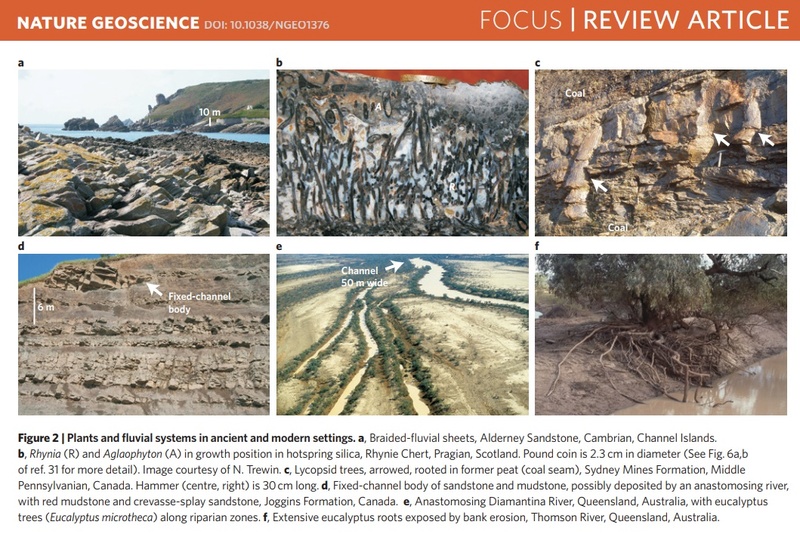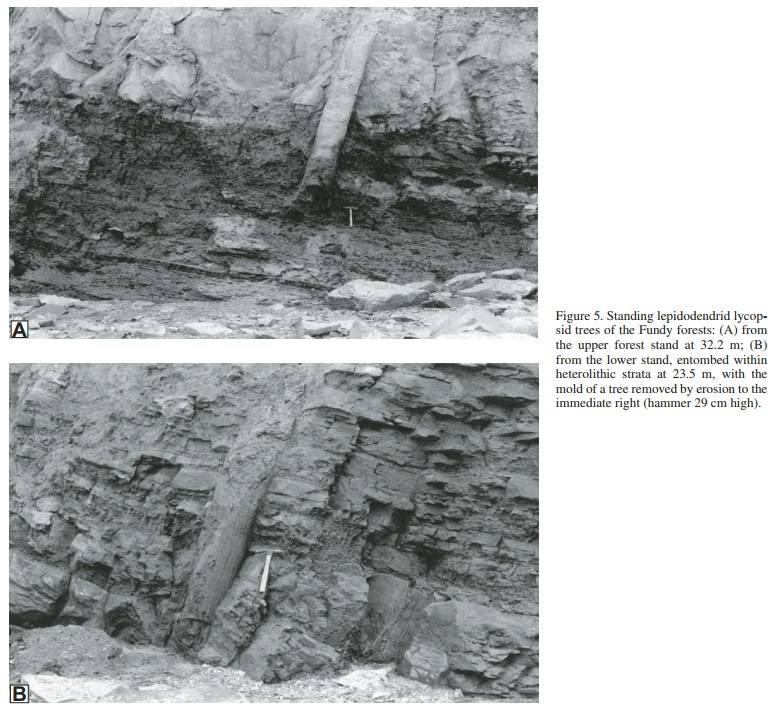Uneven fossil record
http://reasonandscience.heavenforum.org/t1420-uneven-fossil-record
Yet another interesting finding concerning petrified trees , is that many of them extend vertically through millions and millions of years of sedimentary rock. How can this phenomenon be explained? A common explanation is that these do not represent areas of the standard geologic column, but areas of rapid local flooding and sedimentation. Therefore, the layers that these trees pass through do not represent thousands and millions of years. However, the pictures shown to the right are of a petrified tree (located near Katherine Hill Bay next to Flat Rocks Point, Australia) extending up through many sedimentary layers and through two separated coal seams (See Video Below).4 The tree itself is twelve feet tall, and was uncovered by a coal mining company. If the two separated coal seams represent long periods of time, how could this tree be extending between them both? It seems to me that this is a difficulty for the current understanding of science. Notice also that the layers themselves show no weathering between one layer and the next even though each layer was supposedly the surface of the earth for thousands if not millions of years. These combined mysteries are more easily explained by rapid underwater burial with quickly forming sediments. The theory that each fossil bearing layer in the geologic column represents eons of time seems inadequate to explain such problems that are easily explained by a quick catastrophic event.
David Raup, paleontologist
Instead of finding the gradual unfolding of life, what geologists of Darwin's time, and geologists of the present day actually find is a highly uneven or jerky record; that is, species appear in the sequence very suddenly, show little or no change during their existence in the record, then abruptly go out of the record. And it is not always clear, in fact it's rarely clear, that the descendants were actually better adapted than their predecessors. In other words, biological improvement is hard to find.
Stephen J. Gould, paleontologist
All paleontologists know that the fossil record contains precious little in the way of intermediate forms; transitions between major groups are characteristically abrupt.
Simon Conway Morris, evolutionary biologist
William Buckland knew about it, Charles Darwin characteristically agonized over it, and still we do not fully understand it. “It”, of course, is the seemingly abrupt appearance of animals in the Cambrian “explosion.”
Richard Dawkins, The Blind Watchmaker
The Cambrian strata of rocks, vintage about 500 million years, are the oldest ones which we find most of the major invertebrate groups. And we find many of them already in an advanced state of evolution, the very first time they appear. It is as though they were just planted there, without any evolutionary history.
“There’s something damn funny about the stratigraphical record’. The record is spasmodic and ridiculously incomplete, with particular strata and fossils extremely widespread, but separated by vastly longer gaps than anything that is preserved. The same strata and fossils, though to all intents and geological purposes synchronous (laid down at one time), must have spread diachronously (laid down through multiple exposures). Traditional ideas such as gentle, continuous sedimentation (and perhaps similarly continuous evolution) are not adequate to explain what we see. Nor is the idea of the ‘stratotype’ satisfactory as a means of establishing and international stratigraphical language. The record is spasmodic and must be treated as such. The ‘layer cake’ analogy just will not do". 1971 a secular geologist, Derek Ager, in particular a specialist in stratigraphy (studies of sedimentary rocks) wrote the book, The Nature of the Stratigraphical Record.
1) http://www.detectingdesign.com/fossilrecord.html
http://reasonandscience.heavenforum.org/t1420-uneven-fossil-record
Yet another interesting finding concerning petrified trees , is that many of them extend vertically through millions and millions of years of sedimentary rock. How can this phenomenon be explained? A common explanation is that these do not represent areas of the standard geologic column, but areas of rapid local flooding and sedimentation. Therefore, the layers that these trees pass through do not represent thousands and millions of years. However, the pictures shown to the right are of a petrified tree (located near Katherine Hill Bay next to Flat Rocks Point, Australia) extending up through many sedimentary layers and through two separated coal seams (See Video Below).4 The tree itself is twelve feet tall, and was uncovered by a coal mining company. If the two separated coal seams represent long periods of time, how could this tree be extending between them both? It seems to me that this is a difficulty for the current understanding of science. Notice also that the layers themselves show no weathering between one layer and the next even though each layer was supposedly the surface of the earth for thousands if not millions of years. These combined mysteries are more easily explained by rapid underwater burial with quickly forming sediments. The theory that each fossil bearing layer in the geologic column represents eons of time seems inadequate to explain such problems that are easily explained by a quick catastrophic event.
David Raup, paleontologist
Instead of finding the gradual unfolding of life, what geologists of Darwin's time, and geologists of the present day actually find is a highly uneven or jerky record; that is, species appear in the sequence very suddenly, show little or no change during their existence in the record, then abruptly go out of the record. And it is not always clear, in fact it's rarely clear, that the descendants were actually better adapted than their predecessors. In other words, biological improvement is hard to find.
Stephen J. Gould, paleontologist
All paleontologists know that the fossil record contains precious little in the way of intermediate forms; transitions between major groups are characteristically abrupt.
Simon Conway Morris, evolutionary biologist
William Buckland knew about it, Charles Darwin characteristically agonized over it, and still we do not fully understand it. “It”, of course, is the seemingly abrupt appearance of animals in the Cambrian “explosion.”
Richard Dawkins, The Blind Watchmaker
The Cambrian strata of rocks, vintage about 500 million years, are the oldest ones which we find most of the major invertebrate groups. And we find many of them already in an advanced state of evolution, the very first time they appear. It is as though they were just planted there, without any evolutionary history.
“There’s something damn funny about the stratigraphical record’. The record is spasmodic and ridiculously incomplete, with particular strata and fossils extremely widespread, but separated by vastly longer gaps than anything that is preserved. The same strata and fossils, though to all intents and geological purposes synchronous (laid down at one time), must have spread diachronously (laid down through multiple exposures). Traditional ideas such as gentle, continuous sedimentation (and perhaps similarly continuous evolution) are not adequate to explain what we see. Nor is the idea of the ‘stratotype’ satisfactory as a means of establishing and international stratigraphical language. The record is spasmodic and must be treated as such. The ‘layer cake’ analogy just will not do". 1971 a secular geologist, Derek Ager, in particular a specialist in stratigraphy (studies of sedimentary rocks) wrote the book, The Nature of the Stratigraphical Record.
1) http://www.detectingdesign.com/fossilrecord.html
Last edited by Admin on Tue Aug 18, 2020 7:09 am; edited 4 times in total




